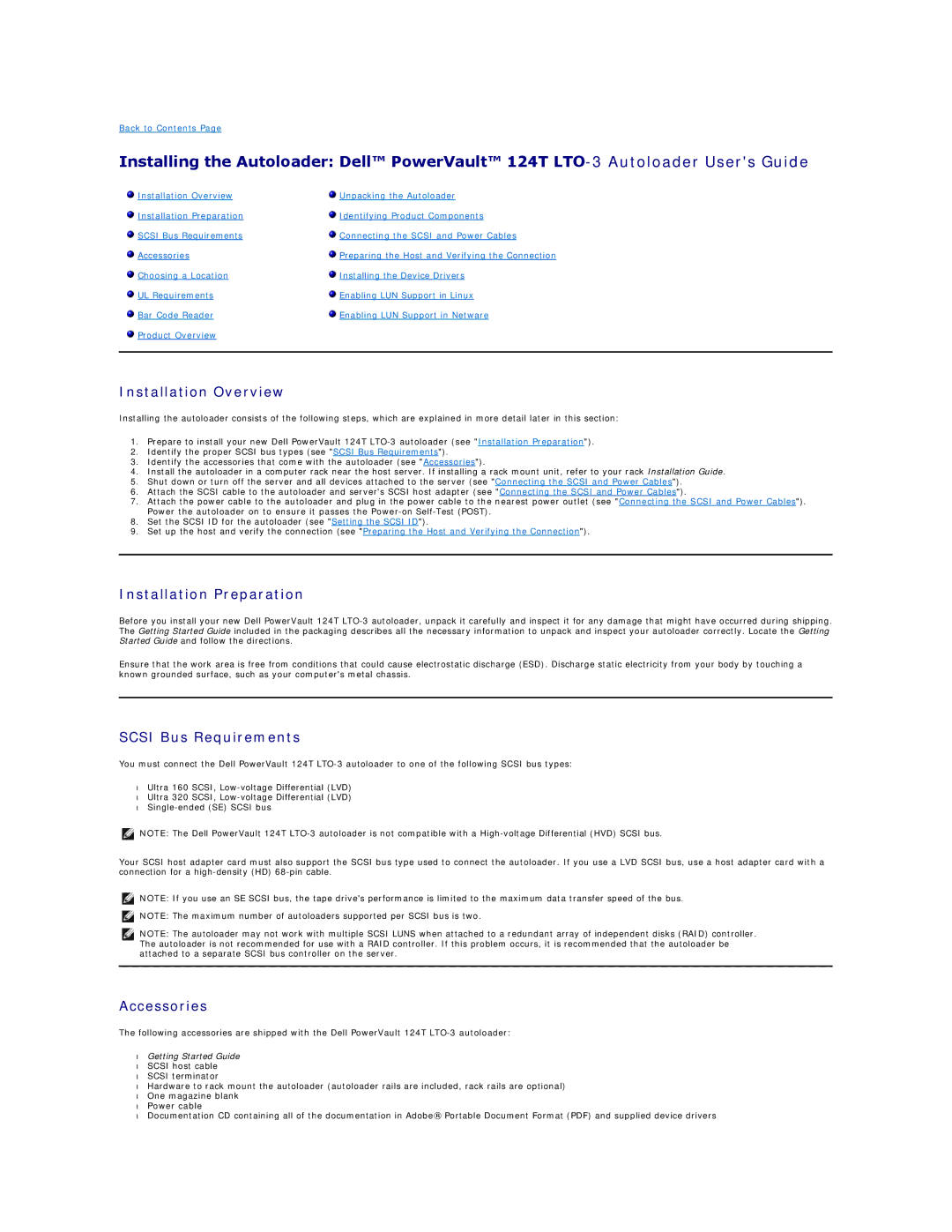
Back to Contents Page
Installing the Autoloader: Dell™ PowerVault™ 124T
Installation Overview | Unpacking the Autoloader |
Installation Preparation | Identifying Product Components |
SCSI Bus Requirements | Connecting the SCSI and Power Cables |
Accessories | Preparing the Host and Verifying the Connection |
Choosing a Location | Installing the Device Drivers |
UL Requirements | Enabling LUN Support in Linux |
Bar Code Reader | Enabling LUN Support in Netware |
Product Overview |
|
|
|
Installation Overview
Installing the autoloader consists of the following steps, which are explained in more detail later in this section:
1.Prepare to install your new Dell PowerVault 124T
2.Identify the proper SCSI bus types (see "SCSI Bus Requirements").
3.Identify the accessories that come with the autoloader (see "Accessories").
4.Install the autoloader in a computer rack near the host server. If installing a rack mount unit, refer to your rack Installation Guide.
5.Shut down or turn off the server and all devices attached to the server (see "Connecting the SCSI and Power Cables").
6.Attach the SCSI cable to the autoloader and server's SCSI host adapter (see "Connecting the SCSI and Power Cables").
7.Attach the power cable to the autoloader and plug in the power cable to the nearest power outlet (see "Connecting the SCSI and Power Cables"). Power the autoloader on to ensure it passes the
8.Set the SCSI ID for the autoloader (see "Setting the SCSI ID").
9.Set up the host and verify the connection (see "Preparing the Host and Verifying the Connection").
Installation Preparation
Before you install your new Dell PowerVault 124T
Ensure that the work area is free from conditions that could cause electrostatic discharge (ESD). Discharge static electricity from your body by touching a known grounded surface, such as your computer's metal chassis.
SCSI Bus Requirements
You must connect the Dell PowerVault 124T
•Ultra 160 SCSI,
•Ultra 320 SCSI,
•
NOTE: The Dell PowerVault 124T
Your SCSI host adapter card must also support the SCSI bus type used to connect the autoloader. If you use a LVD SCSI bus, use a host adapter card with a connection for a
NOTE: If you use an SE SCSI bus, the tape drive's performance is limited to the maximum data transfer speed of the bus.
NOTE: The maximum number of autoloaders supported per SCSI bus is two.
NOTE: The autoloader may not work with multiple SCSI LUNS when attached to a redundant array of independent disks (RAID) controller. The autoloader is not recommended for use with a RAID controller. If this problem occurs, it is recommended that the autoloader be attached to a separate SCSI bus controller on the server.
Accessories
The following accessories are shipped with the Dell PowerVault 124T
•Getting Started Guide
•SCSI host cable
•SCSI terminator
•Hardware to rack mount the autoloader (autoloader rails are included, rack rails are optional)
•One magazine blank
•Power cable
•Documentation CD containing all of the documentation in Adobe® Portable Document Format (PDF) and supplied device drivers
